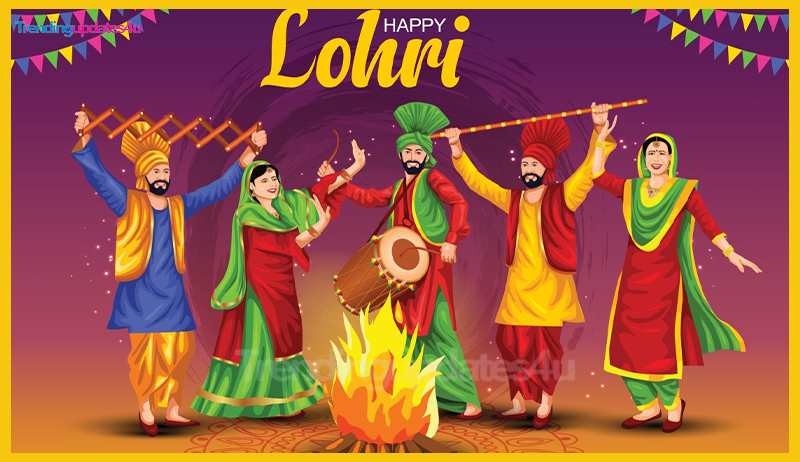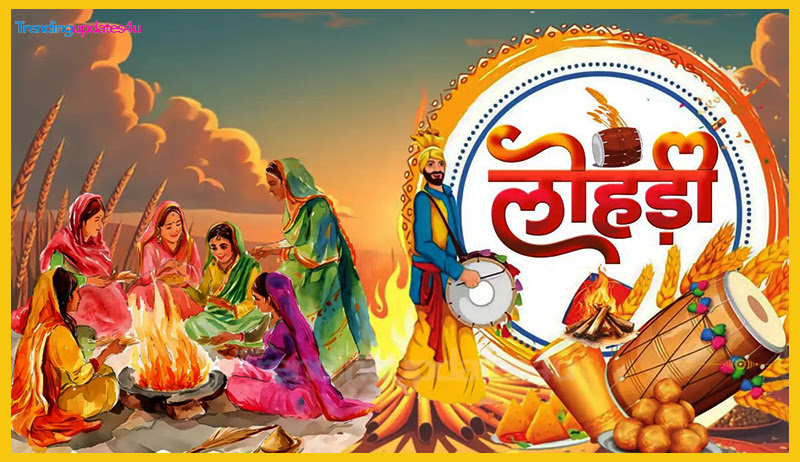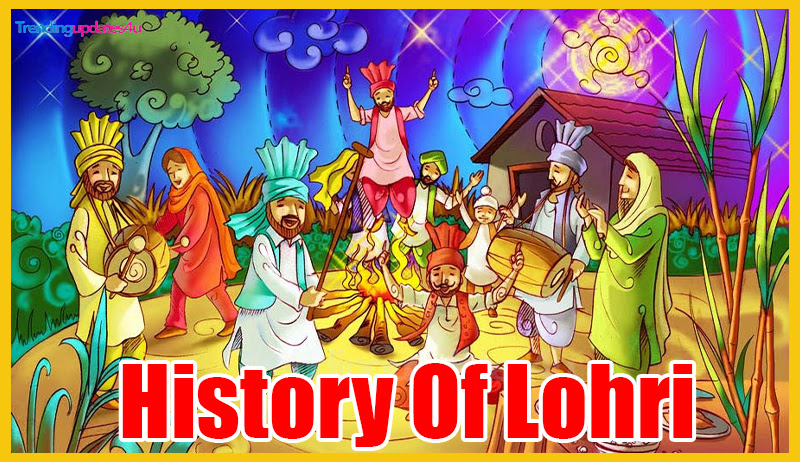Lohri 2025:- Lohri, also known as Lal Loi, is a vibrant midwinter festival celebrated primarily in Northern India, especially in the Punjab region. This cultural and seasonal festival is deeply rooted in folklore and traditions that mark the end of winter solstice and the arrival of longer days. Below is an in-depth look at Lohri 2025, including its date, time, history, and significance.
Lohri (लोहड़ी) 2025
Lohri is a popular Punjabi folk festival celebrated primarily in Northern India during the winter season. The festival holds significant cultural and historical importance, particularly in the Duggar and Punjab regions. Many believe Lohri marks the passing of the winter solstice, symbolizing the end of winter and welcoming longer days as the sun begins its journey toward the Northern Hemisphere. It is traditionally observed on the night before Maghi.

Lohri is an official holiday in Punjab, Jammu, and Himachal Pradesh. While it is celebrated in Delhi and Haryana, it is not recognized as a gazetted holiday. The festival is widely enjoyed by Sikhs, Hindus, and anyone who wishes to partake in the festivities. In Punjab, Pakistan, Lohri is not officially observed, but Sikhs, Hindus, and some Muslims celebrate it in rural areas and cities like Faisalabad and Lahore.
Read More:- Important Days in January 2025
Lohri 2025 Details
| Aspect | Details |
| Article for | Lohri 2025: Date, History, Significance & Celebration |
| Significance | Marks the end of winter, celebrates the harvest season, and the sun’s northward journey. |
| Date of Celebration | Typically falls on January 13th or 14th, the night before Maghi. |
| Main Rituals | Lighting bonfires, singing traditional songs, dancing bhangra and gidda, and sharing festive foods. |
| Traditional Foods | Sarson da saag with makki di roti, til, gajak, revari. |
| Celebrants | Celebrated by Sikhs, Hindus, and people of various communities, primarily in Punjab, Haryana, and other Northern Indian regions. |
| Category | Trending |
What is Lohri?
Lohri, also known as Lal Loi, is a midwinter Punjabi folk festival celebrated predominantly by the Punjabi community. It signifies the passing of the winter solstice and the onset of longer days as the sun transitions toward the Northern Hemisphere.
The festival holds cultural and seasonal importance and is observed with much enthusiasm in Punjab, Haryana, Delhi, and Himachal Pradesh. Lohri is not only about traditions but also about coming together as a community to rejoice and spread happiness.
Lohri Festival Date 2025
Lohri is celebrated a day before Maghi (Makar Sankranti), with its date determined according to the Hindu Solar calendar. The festival’s date shifts gradually over time. In the late 19th century, Lohri was observed on January 11. By the mid-20th century, it was celebrated on January 12 or 13. In the 21st century, Lohri typically falls on January 13 or 14. In 2024, Lohri will be celebrated on January 14, as Maghi is set to occur on January 15.

History Of Lohri
Lohri has been documented by European visitors to the Lahore court of Maharaja Ranjit Singh. Wade, who visited the Maharaja in 1832, mentioned Lohri in his accounts. Similarly, Captain Mackeson described the Maharaja distributing suits of clothes and substantial sums of money as rewards during Lohri celebrations in 1836. In 1844, the royal court noted the tradition of lighting a massive bonfire at night as part of the festivities.
While these royal accounts highlight the celebration of Lohri, they do not delve into its origins. Folklore, however, provides insight into the festival’s significance. Lohri marks the arrival of longer days following the winter solstice. Historically, it was celebrated at the end of the traditional month when the solstice occurred, symbolizing the sun’s northward journey and the lengthening of days. The day after Lohri is observed as Makar Sankranti.

Lohri is an ancient mid-winter festival that originated in regions near the Himalayan mountains, where winters are harsher compared to the rest of the Indian subcontinent. Traditionally, Hindus and Sikhs lit bonfires in their yards after weeks of Rabi season farming work, gathering around the fire to sing, dance, and socialize. The festival symbolizes the end of winter and the beginning of longer, sunnier days.
Lohri Significance
Lohri holds ancient significance as a celebration of the winter crop season and is deeply rooted in the Punjab region. A popular folklore associates the festival with the legend of Dulla Bhatti, also known as Rai Abdullah Bhatti. Dulla Bhatti, a zamindar from Punjab during the reign of Mughal Emperor Akbar, is celebrated as a hero for rescuing Punjabi girls from being forcibly taken and sold in the slave markets of the Middle East. Among those he saved were two girls, Sundri and Mundri, who later became central figures in Punjab’s folklore.
As part of Lohri traditions, children go from house to house singing folk songs that honor Dulla Bhatti, with his name featured prominently. One person leads the singing, and the group enthusiastically ends each line with a loud “Ho!” sung in unison. At the end of the song, the household adult typically gives snacks or money to the young singers. Lohri also signifies the start of the harvest season and the arrival of sunnier days, symbolizing prosperity and joy.
How to Celebrated Lohri Festival?
Lohri is a vibrant festival celebrated with enthusiasm, especially in Northern India. Here’s how the festival is typically celebrated:
- Lighting Bonfires: The central ritual of Lohri involves lighting a large bonfire, symbolizing the end of winter and the arrival of warmer, sunnier days. People gather around the bonfire, toss sesame seeds, jaggery, and sugarcane into the flames as offerings to the fire, while singing traditional Lohri songs.
- Singing and Dancing: Singing and dancing are integral to the celebrations. Traditional folk songs are sung, and people engage in lively dances like bhangra and gidda, accompanied by the beat of the dhol. Children go around houses singing Lohri songs, particularly those that honor the legendary Dulla Bhatti.
- Feasting on Traditional Foods: The festival is known for its special food, including sarson da saag (mustard greens) and makki di roti (cornbread), which is typically served as the main dish. Other treats like til (sesame seeds), gajak (a sweet made from sesame and jaggery), and revari are also commonly enjoyed.
- Private Family Gatherings: Most families celebrate Lohri at home, often inviting relatives, friends, and neighbors to join in the festivities. In homes where there has been a recent marriage or birth, the celebrations are usually more elaborate.
- Exchanging Gifts: During Lohri, people often exchange small gifts, sweets, and money as a sign of goodwill and prosperity.
- Dressing in Bright Clothes: Participants typically wear vibrant, colorful clothes to add to the joyous atmosphere of the festival.
- Community Celebrations: While many people celebrate Lohri in their homes, larger community celebrations, especially in rural areas, feature bonfires, music, and collective dancing.
- Spiritual Significance: Lohri also has spiritual significance, as it marks the end of the winter crop season, especially for farmers, and is a time for expressing gratitude for the harvest.
Conclusion
Lohri is a joyous celebration that marks the end of winter and the beginning of longer, sunnier days. It brings people together through bonfires, dancing, singing, and feasting on traditional foods. The festival holds cultural, spiritual, and agricultural significance, particularly for farmers, while also fostering a sense of community and togetherness. Whether celebrated in private family gatherings or large community events, Lohri spreads warmth, happiness, and prosperity, creating lasting memories for all who partake in its festivities.
FAQ’s
What is the significance of Lohri?
Lohri marks the end of winter and celebrates the arrival of longer days, symbolizing the sun’s northward journey. It is a time to honor the harvest and give thanks for the crops, especially for farmers.
When is Lohri celebrated?
Lohri is celebrated on the night before Maghi, usually falling on January 13 or 14 each year, depending on the lunar calendar.
How is Lohri celebrated?
Lohri celebrations include lighting bonfires, singing traditional songs, dancing bhangra and gidda, enjoying festive foods like sarson da saag with makki di roti, and exchanging gifts.
What are the traditional foods of Lohri?
The main dish served during Lohri is sarson da saag with makki di roti. Other treats include til (sesame seeds), gajak, and revari.
Who celebrates Lohri?
Lohri is primarily celebrated by Sikhs, Hindus, and people of various communities in North India, especially in Punjab, Haryana, Delhi, and Jammu. It is also celebrated in parts of Pakistan.
Is Lohri a public holiday?
Lohri is an official holiday in states like Punjab, Jammu, and Himachal Pradesh. However, in other regions, it is not a gazetted holiday but still widely celebrated.
What is the story behind Lohri?
Lohri is linked to the legendary figure Dulla Bhatti, who is celebrated for rescuing Punjabi girls from being sold into slavery. His story is an essential part of the folk songs sung during the festival.
Related Posts:-